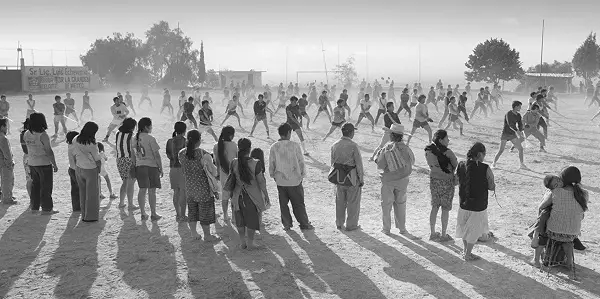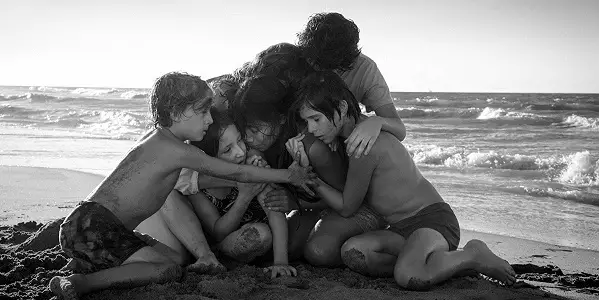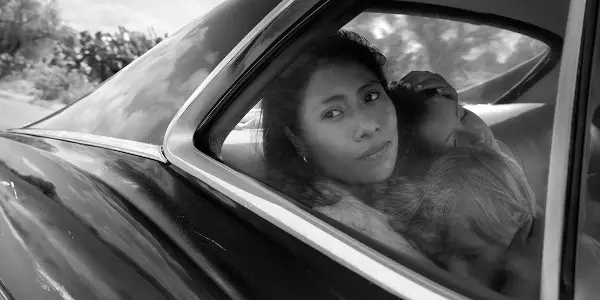ROMA: Cuarón Crafts A Masterpiece From Memory

Seattle area film critic and aspiring screenwriter. My reviews can…
Watching Alfonso Cuarón’s beautiful new film Roma feels like sitting atop a leaf as it floats down a stream. We passively survey the landscape, luxuriating in the sights and sounds, barely aware that the forceful current is controlling our perspective completely. In this case, that current is the assured hand of Cuarón, who turns his technical and artistic prowess towards a humble domestic worker and her chaotic household.
Seemingly about nothing and everything simultaneously, this year-in-the-life story quietly (yet forcefully) observes the repetition and tragedy that punctuates our mundane existence. Roma isn’t merely a chronicle but an invitation to engage life and all of its glorious terror.
First: Airplanes & Muscle Men
There is scene in Roma, one which arrives like some strange aberration, in which a group of passionate young men practice martial arts in the swirling dust of a massive dirt field. When their gyrations and furious stick swinging ceases, they find a famous television strongman named Profesor Zovek (played by a man credited as Latin Lover) standing before them. As if performing the greatest trick in the world, Profesor Zovek ceremoniously closes his eyes and stands ramrod-straight on one leg (in yoga parlance, this is called “Tree Pose”). One by one, the dismissive students topple over, incapable of emulating the Profesor’s ‘easy’ trick.
This playful, random, and deceptively poignant scene encapsulates everything wonderful about writer-director Alfonso Cuarón’s semi-autobiographical tale. Mostly, it reminds us that the most difficult thing in the world is to remain calm as the storm rages around us; to stay focused on the ridiculous notion that we even exist. Roma is a film that embraces these quiet moments with true artistic abandon.

These are not merely voyeuristic trifles, however, granting us a peek at life through the swaying reeds. Cuarón’s assured vision guides our attention in every scene. Even as we gaze upon the ridiculous Profesor Zovek, a passing airplane draws our attention above. It is one of many airplanes that fly lazily overhead during the course of Roma. Why does Cuarón bother with such a trivial indulgence? Because he wants you to notice that airplane… he wants you to notice everything.
And Now The Guts Of It
Of course, Roma isn’t about airplanes and strongmen. It’s a story about two strong women, each struggling at opposite ends of the socioeconomic spectrum. Yalitza Aparicio makes her acting debut as Cleo, an unassuming housemaid who is quick to smile and reluctant to speak. The lady of the house, Sofía (Marina de Tavira), leans heavily upon her young maid for emotional support, particularly since her husband, Doctor Antonio (Fernando Grediaga), is frequenting their luxury townhouse less and less these days.
Their home rests in the bustling Roma district of Mexico City, circa 1970. Culled straight from Cuarón’s memories of Mexico in the late-60s/early-70s, the landscape is laden with delicious details. Marching bands amble through the streets as shoppers clamor for treasure in the meticulously re-created town square. Wisely, Cuarón abandons a traditional soundtrack in favor of a naturalistic soundscape. In the distance, dogs bark and children squeal, and we hear music…. always the faraway hint of music chiming just on the edge of our awareness.

Filmed in gorgeous black-and-white and packed with naturalistic performances from unknown actors, Roma evokes the feel of classic Italian neorealism, with its focus riveted on the precarious existence of middle-class families. Cuarón, who also serves as the film’s cinematographer, leisurely pans his camera from side to side, using the massive frame to absorb every detail.
He leads your gaze precisely where you need to go, allowing his characters, already enmeshed in conversation, to drift into and out of frame. Cinephiles will thrill to the technical mastery, such as the camera following Cleo on her daily ritual of turning off the lights, providing an impromptu 360 degree tour of the impeccable decorated townhouse.
More Human Than Human
What impresses the most about Roma is its uncompromising pace. It’s a mirror of reality, where routine and ritual is occasionally disrupted by an indifferent universe. Cleaning dog poop off the driveway holds just as much sway over Cuarón’s attention as an earthquake. It’s a world where bedtime stories and civil unrest co-exist, sometimes on the same day. Allowed to unfold with neither limitation nor judgement, each event in Cleo’s life plays out with almost Shakespearean import.
Much like life, again, not everything in Roma lends itself to obvious interpretation. Cuarón doesn’t provide the details on matters peripheral to his story. We don’t know for sure what Doctor Antonio is up to, but we know damn well his relationship with Sofía is doomed. The history behind the Corpus Christi student massacre of 1971 may be unknown to most viewers, but Cuarón’s utter commitment to its terrifying re-creation elevates it beyond the realm of a mere plot point. This is life and death and, most importantly, all of the stuff that comes in between.

But Cuarón still allows time for playfulness, even if the situation smolders with danger. As adults struggle to douse a raging fire before it reaches their home, the children create a game of carrying the water buckets to and from the inferno. Plunging into the Meta level, we recognize allusions to Cuarón’s 2013 film, Gravity, as Cleo and the children watch the 1969 sci-fi blockbuster, Marooned. These flourishes may feel whimsical and out of place, but what is life if not a collection of absurd, indefinable moments that come to define us.
Roma: Conclusion
While the pacing, meandering plot, and showy camerawork will prove challenging to some viewers, the rewards of Roma are well worth the effort. This is the kind of film that makes you look at the world differently; makes you see those things that felt previously inconsequential. The first thing I noticed upon exiting the theater was an airplane flying overhead. And why did I notice that airplane? Because Alfonso Cuarón wanted me to notice everything.
If you could make an autobiography about one year in your life, which year would it be? Share your thoughts in the comments below.
Does content like this matter to you?
Become a Member and support film journalism. Unlock access to all of Film Inquiry`s great articles. Join a community of like-minded readers who are passionate about cinema - get access to our private members Network, give back to independent filmmakers, and more.
Seattle area film critic and aspiring screenwriter. My reviews can be found in The Seattle Times, PopMatters, Nonfics, Goomba Stomp, and Sound on Sight, just to name a few. Post-rock is kind of my obsession, so I'm probably listening to it right now...













